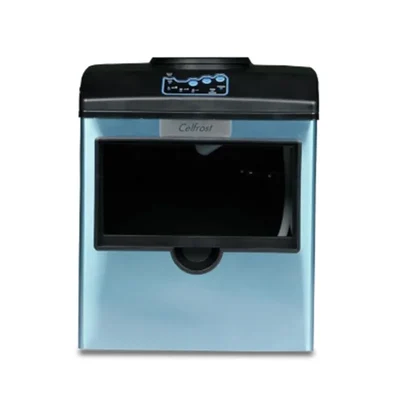- Farm & Garden
- Pumps & Motors
- Food Processing
- Workshop, DIY & MRO

Brand: Celfrost
Celfrost Countertop Ice Cube Making Machine Ice Production Capacity 15 kgs/24hrs, (Model IC-15 BW) For Bars, Restaurants
SKU: TI-C1-41282 Delivery By: Dec 19 - Dec 21
Delivery By: Dec 19 - Dec 21 




MRP : ₹39990 ₹29999
25% OFF!
 Delivery By: Dec 19 - Dec 21
Delivery By: Dec 19 - Dec 21 
Easy Return
& Refund
& Refund

Quality
Assurance
Assurance

Trusted
Delivery
Delivery

After Sales
Assistance
Assistance

Buyer
Protection
Protection
₹29999 (Including GST)
MRP : ₹39990
25% OFF!
Get Extra ₹450 OFF on Prepaid Orders
QTY :
-
1
+
Short Description
Celfrost Ice Cube Making Machine
Output Capacity 15kg/24hrs
Country of origin: India
Specifications
- Brand: Celfrost
- Weight (Approx.) : 15 kg
- Material : Stainless Steel
- Ice Form: Bullet Ice
- Model no. IC-15 BW
- Dimensions : 15.6x17.2x18.5 inch (39.624 * 43.688 * 46.99 Cm )
Description
This Celfrost 15kg/24hrs Ice Cube Making Machine is a compact and efficient appliance designed to produce a steady supply of ice cubes for various commercial and residential uses. Ideal for small cafes, bars, restaurants, offices, and even larger homes, this machine boasts a daily ice production capacity of 15 kilograms within a 24-hour period. Engineered for convenience and reliability, it typically features a user-friendly interface and a self-contained design, making it a valuable asset for establishments requiring a consistent supply of ready-to-use ice.
Features
:Compact Design & Production Capacity: Offers a modest footprint suitable for countertop placement while delivering a significant 15kg of ice per day, making it ideal for moderate ice demands. It typically includes an integrated ice storage bin to hold the freshly made cubes.
User-Friendly Operation: Features intuitive controls, often with an indicator for ice full or water low, simplifying operation. Many models are plug-and-play, requiring minimal setup beyond power and a water connection.
Efficient Ice Making: Utilizes an efficient refrigeration system to quickly produce clear, solid ice cubes. The ice shape is typically standard cubes or bullet-shaped, suitable for various beverages.
Durable & Hygienic Construction: Built with food-grade materials, commonly stainless steel or high-quality plastics, ensuring hygiene and easy cleaning. The construction is designed to withstand continuous operation in commercial settings.
Water Connection & Drainage: Designed for a direct water line connection for continuous ice production, eliminating manual refilling. It also includes a drainage system for proper water management, often requiring a connection to a drain.
Applications
:Food & Beverage Industry: Small cafes, coffee shops, juice bars, fast-food outlets, small restaurants, and pubs for serving chilled beverages.
Hospitality: Hotel mini-bars, bed and breakfasts, guest houses, and small event caterers.
Corporate & Office Use: Staff canteens, break rooms, and meeting areas for refreshing drinks.
Healthcare: Clinics and small medical facilities for ice packs or cold compresses.
Residential & Event Use: For large families, home parties, and small private events requiring a consistent supply of ice.
Usage
:Installation: Place the machine on a stable, level surface with adequate ventilation. Connect it to a potable water supply using the provided hose and ensure the drain hose is directed to a suitable drainage point.
Initial Setup: Plug the machine into a dedicated power outlet. Before first use, it's advisable to run a cleaning cycle or discard the first few batches of ice to ensure cleanliness.
Operation: Turn on the machine. It will automatically start the ice-making cycle, drawing water, freezing it into cubes, and dispensing them into the storage bin. Monitor the 'ice full' or 'water low' indicators if present.
Ice Retrieval: Open the access door or lid to retrieve ice cubes from the storage bin using a scoop . Close the door promptly to maintain ice quality.
Shutdown: For short periods, the machine can be left running. For longer periods of non-use, turn off the machine, disconnect the water supply, and drain any remaining water from the system.
Regular Cleaning: Perform a descaling and sanitization cycle using a food-grade ice machine cleaner to prevent mineral buildup and bacterial growth.
External Cleaning: Wipe down the exterior of the machine regularly with a damp cloth and mild detergent to keep it clean and hygienic. Avoid abrasive cleaners.
Air Filter Cleaning: If the machine has an air filter, clean or replace it periodically to ensure efficient condenser operation and prevent dust accumulation.
Drainage System Check: Regularly check the drain hose and storage bin for any blockages or buildup of slime. Ensure the drain is clear to prevent water overflow and contamination.
Water Supply & Bin Hygiene: Ensure the water supply connection is secure and leak-free. Keep the ice storage bin clean and empty it entirely before prolonged shutdown periods to prevent mold or odor development.

Select attribute







